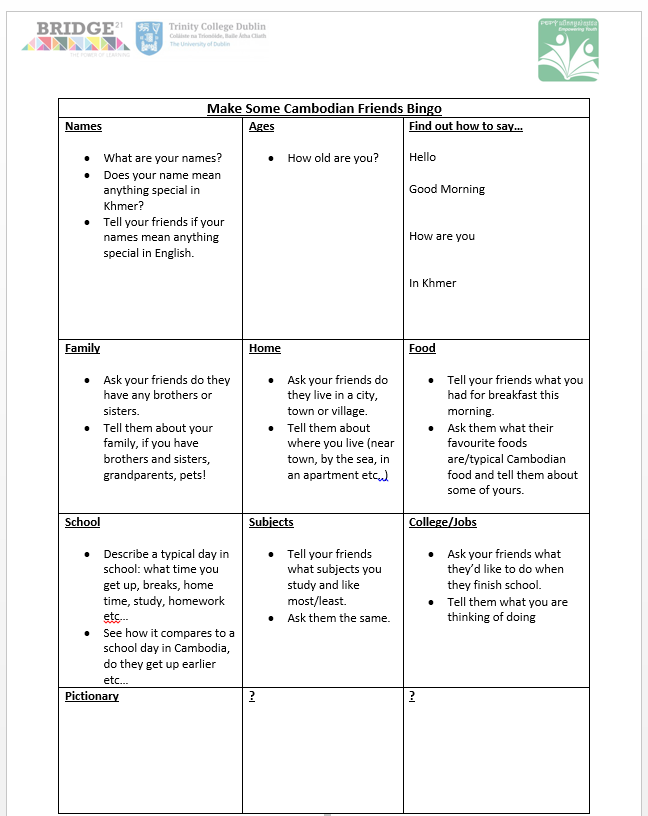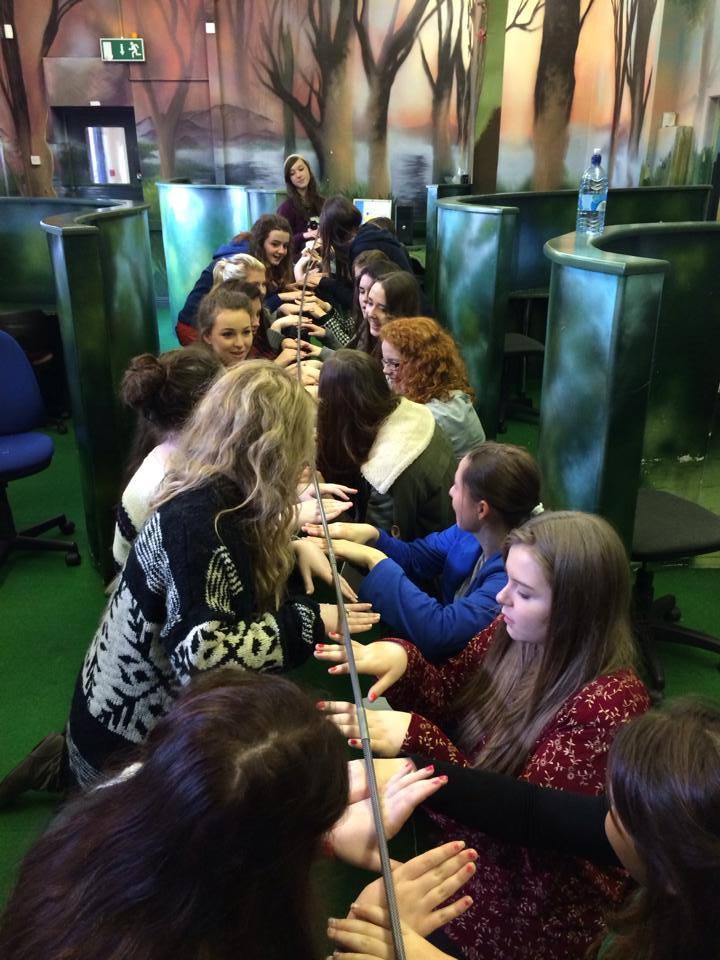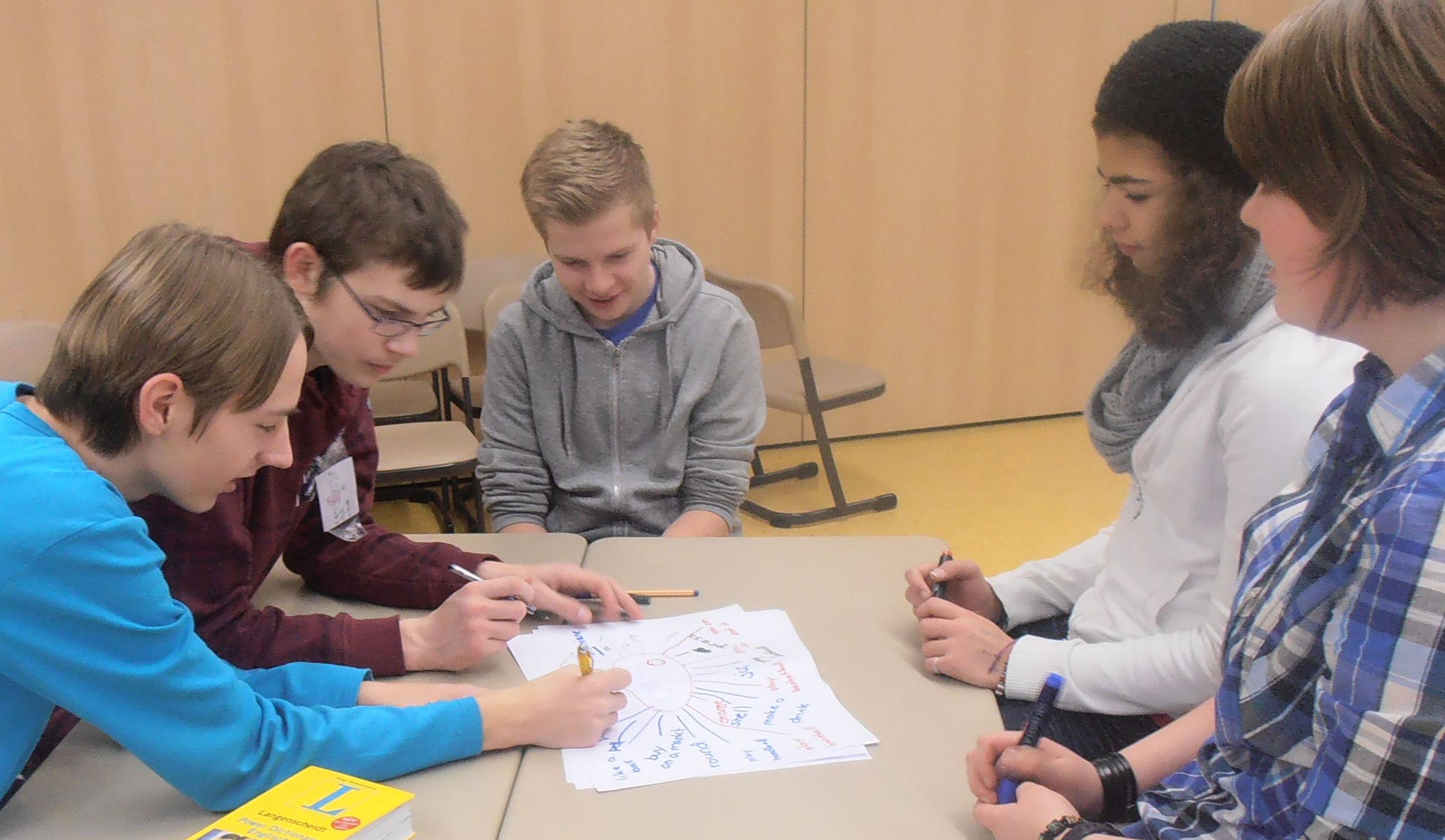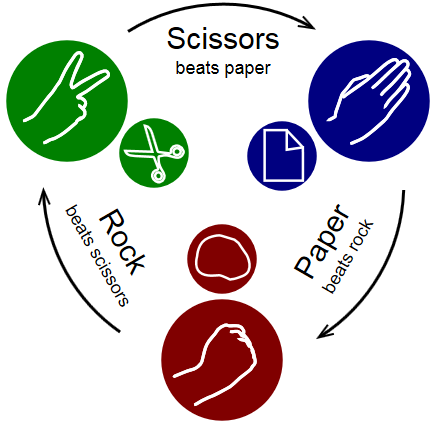This page provides some sample activities for the set-up section of the Bridge21 activity model.
| # Players | Resources | Instructions | Objectives/Outcomes | |
| Autograph Bingo | Full class | One Autograph Bingo card per player | The card contains a grid full of statements. The player must find somebody within the group about whom each statement is true and get them to sign beside that statement. Each player can only sign each card once. Go for four corners, a full line or a full house! | The objective of the game is to get the group talking to each other and to learn a little bit about each other. Some interesting discussions can lead from checking that the signatories really do match the statements they have signed. |
| Magic Bridge
|
Full class | A piece of string long enough for the full group to stand on | Each player must stand on the “bridge”. They can safely take one foot off the bridge. If they take both feet off the bridge, they fall off! To be allowed cross the bridge, the group must arrange themselves in a specified order (e.g. alphabetically, by birthday) without anybody falling off the bridge. | This game encourages communication and teamwork. A follow-up discussion about thinking about their team-mates as well as themselves (e.g. stepping back to let people pass) and a second attempt at the game is worthwhile. |
| Pole game
|
Full class.
16 minimum. 20+ ideal. |
A long tent pole or similar.
A stop-watch. |
The group should arrange themselves along both sides of the pole so that everyone is holding onto it at waist/chest height. They should then let the pole rest on the backs of their hands. Their task is to place the pole on the ground. If anyone’s hands come away from the pole the whole group must start again. If anyone pushes down on the pole with any part of their body, the whole group must start again.
|
This game requires communication, collaboration and patience. And it only takes one person to ruin it for everyone! This simple task becomes more difficult with every extra player. A follow-up conversation about why it was so difficult is worthwhile. |
| Brainstorming
|
Full class, in teams | One whiteboard/A3 page per team
One marker/pen per person |
Each team is given 5 minutes to write down at least 30 different things they could do with an orange. (A paper clip also works well for this) There is no criticism allowed, it is about quantity not quality and no idea is too crazy or impossible! Once the time is up, ask each team to give one idea. This can be done several times until good ideas start drying up. | This game encourages creativity. It is an ideal intro to a larger activity that may begin with a brainstorming phase. |
| Rock Paper Scissors Tournament
|
Full class | Understanding neighbours. It only lasts for a minute but it can get noisy! | Everybody plays one game of Rock Paper Scissors against a random opponent. The winner becomes a “Champion” and the loser is out and becomes a “Supporter”. Each Champion quickly finds another Champion and plays another game, while the Supporters must cheer and chant the name of their Champion. Defeated Champions become Supporters. After 2 wins, a Champion has 3 Supporters. After a 3rd win, they have 7. We quickly have two Champions left, each with roughly half the class shouting for them. | This game is really about the Supporters. As part of a team, you may not always get your own way but you will have to join in and work hard for the team whether your idea got chosen or not! |
| Truth Game
|
One team | One set of “Truth Game” questions | The questions are laid out face down. Each player chooses a question at random and must answer honestly. This can be repeated a few times. | This game lets the players get to know each other and helps develop trust among the team. |
| Winter Survival Game
|
Full class, in teams | One “Winter Survival” info pack per team. One “Winter Survival” answer sheet per person. One set of “Expert Answers” for the teacher. | Each player must rank the 12 items in order of importance on their own. Then, each team must agree a set of team rankings. The rankings are compared to the “Expert” rankings to determine a team score. An exact match with the expert ranking scores 0. If the team are out by 1, they get 1 point. If they are out by 5, they get 5 points. The team receive a score for each of the 12 items. These are totalled at the end. Lower score means a better chance of survival! | This game introduces elements of planning, logic and critical thinking as well as negotiation within the team. Forcing each player to write down their individual answers first gives a clear starting point for each player in the team discussion. |
| Introduce a team-mate | Full class, in teams | Whiteboard/Pen and paper optional | Each member of the team must introduce one of their team-mates to the rest of the group. They must include at least 3 pieces of information about their team-mate and name, age or school do not count! | This games helps a team to get to know each other and is a very simple introduction to planning and delivering a presentation. |
| Team Name | Full class, in teams | Each team must agree on a team name. This will be their name for the day/week/year/duration of the project. Each team announces their name to the group. | This helps establish a sense of collective identity. It can be surprisingly hard to make this decision as a team, particularly with Senior Cycle students. | |
| Team Charter | Full class, in teams | Pen and paper | Each team must agree on a set of team rules. The rules specifically refer to working in a team. A group discussion beforehand about the difference between working in a team and working alone is useful. Each member of the team must sign their charter and one member of the team must keep it safe! | This works well with younger students and may help students adjust to a “team” mindset for a collaborative project. |
| Pen grab | Full Class in teams | 6-10 Pens, markers, bottles (anything you can grab)
Chairs
|
Each team lines up behind a chair with a centre chair in middle
Place all pens on centre chair Give each team mate a number, when a number is called that team mate has to take a pen from middle chair one pen at a time to try and get 3 pens on their team chair. Team mate may also “steal” from other teams’s chairs but may only handle one pen at a time. Game ends when a team reaches a set number of points (best to 5 etc)
|
Adjust number of pens if too hard/easy
Need at least 3 teams to play but works as well with 5/6 Hyper game but a good icebreaker for adults and students! |
| Chocolate Relay | Full Class in Teams | One bar of chocolate per team
One die per team One knife fork and plate per team One pair of gloves, hat, scarf per team
|
Put teams in a lines and give each team mate a number
Give each first member a die, when they roll a 1 they run to the chocolate bar on a plate, put on the clothes and try to open the bar using a knife and fork (including taking off wrapper etc..) While they do this the second team members are trying to roll a 2, when they do roll their 2, they run up to the first player who must stop, take off the clothes and give them to number two while the 3rd team mate is trying to roll a 3 an so on.. The game ends when a team successfully eats the bar of chocolate.
|
Any clothes work with this and add to the craic e.g dressing gown, ski goggles etc..
You could also wrap the bar in layers of newspaper and sellotape if you have time. |
|
The Magic Caterpillar |
Full Class in teams |
A Ball or beanbag per team Blindfolds (optional) |
Team stands in a line. When you say go the first team member passes ball/bag over their head, next member puts ball under their legs, next passes it over their head etc..until it gets to teammate at back of line who runs to the front and becomes the new “head” of the caterpillar. Game ends when team reach a fixed point/finish line |
Works best in long room or hall. If done in a shorter room you can make team go backwards when they reach a point. Variation is to blindfold all team mates expect for one who acts as the guide. The guide may not touch their team mates but instructs them verbally. Good leadership exercise for students. |
| 5 consecutive passes | Up to three teams of 4-5 at once (works with 2 teams also) | Ball
|
A team must get 5 consecutive passes to within their team to win without having the ball intercepted by opposing teams.
Ball cannot be passed back between team mates |
Need good indoor space for this or outdoors
Can also be played with a Frisbee. Encourages teamwork, eye contact and including team members.
|
| Stepping Stones | Full class in teams | 2/3 planks of wood/cardboard etc (depends on team size)… | Teams have to get from starting point to finish without touching grass, carpet etc using just the planks they have to stand on.
Requires teams to huddle together, stand on one leg, re-uses planks passing them up the line etc.. |
Allow teams time to discuss a plan first and use their initiative to get across the “river”.
|
| Confusion | Full class in teams | Chairs for whole class | Give each team a different set of instructions.
1. Get chairs in a circle 2. Put chairs facing out and facing in intermittently 3. Get boys to sit on right side of room, girls on left 4. Get girls to sit with arms up, get boys to sit with arms crossed Explain to each team individually that it is their job to ensure the instruction is carried out quickly. Game ends when all teams instructions are carried out, |
Good example of importance of communication especially when sharing resources.
Inevitability there will be mayhem at the beginning, note things said, way people behave for discussion afterwards.
|





You must be logged in to post a comment.